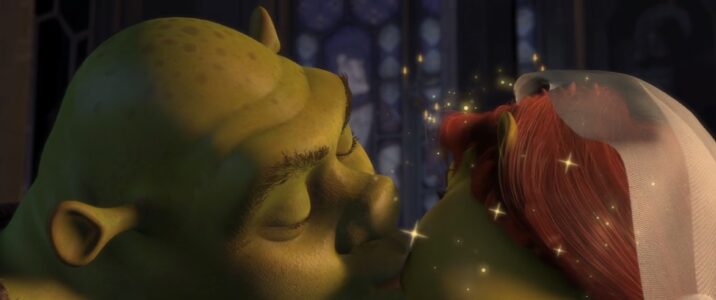Power is most typically associated with authority, decision making, and ultimate control. However, that is not how feminist author and critic Elizabeth Janeway defines it in her 1980 book Powers of the Weak. In it, she explains that power only exists if a relationship is established between a ruler and the governed. “What the powerful need is the consent of the governed to their actions as proper, acceptable, free of blame, and this consent can be granted only by the governed, the other member of the power relationship.” So, one of the best ways to remove a ruler’s power is to dissent. And some of the best modern-day evidence of that definition of power is the movie Shrek.
Shrek is more than just a meme. I mean, yes, I did rediscover my love for the 2001 Dreamworks classic because it became a ubiquitous meme in 2011. But it really is a true masterpiece. And it’s not just because of the cutting-edge animation (for 2001), the witty satire, or heartfelt message. It’s because of its role as a piece of anti-authoritarian media.
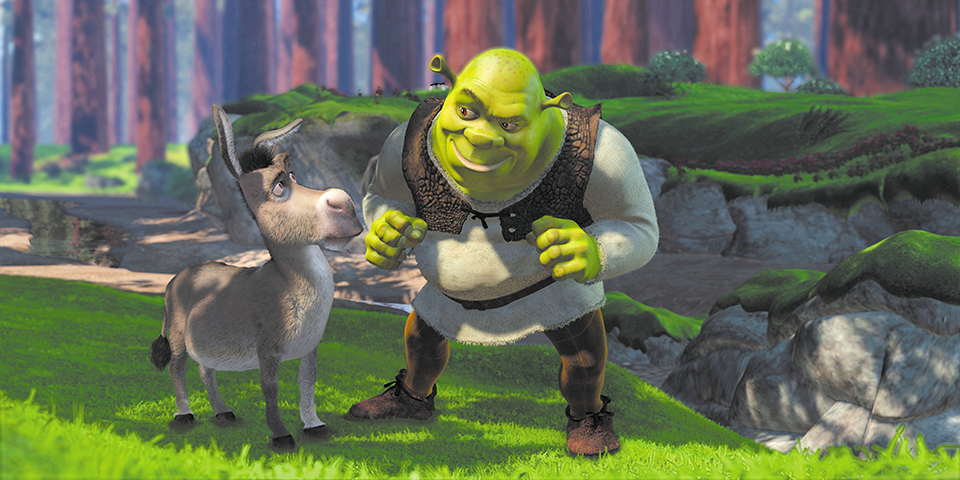
For those that do not know the tale of Shrek, it is the story of a big, ugly, scary ogre named Shrek whose land is being stolen by Lord Farquaad. For him to get his land back, he must rescue the princess that Farquaad desires to marry in order to become a king. With his noble donkey by his side, Shrek rescues the beautiful, feisty Princess Fiona from her tower, that is guarded by an evil dragon. But along the way back from their treacherous journey, Shrek and Princess Fiona learn that they may not be so different after all.
Upon first watch, this story has a beautiful message to teach kids: true beauty is what lies within. But upon further examination, Shrek is a much more complex yet still child-friendly explanation of systemic oppression and how it impacts our sense of self and those around us. This is a tall order for a ninety-five-minute PG-rated film that is filled with fart jokes. But the filmmakers do this through their allegorical use of fairy tale creatures to represent marginalized identities, defying audience expectations of already established folkloric characters, and making the villain of the movie an explicitly gentrifying, eugenics-friendly colonizer.
Within five minutes of the movie, we see chained up dwarves sulking. We see Mama and Papa Bear in a big cage, and Baby Bear in a small cage crying, “this cage is too small”. We see humans walking up to knights to exchange fairy tale creatures for money. While we have not met Farquaad yet, this is our introduction to his reign of terror on the kingdom he rules. This scene is also our introduction to Donkey, who is trying to escape being shackled by the knights. He runs through the forest until he collides with Shrek, who he then cowers behind.
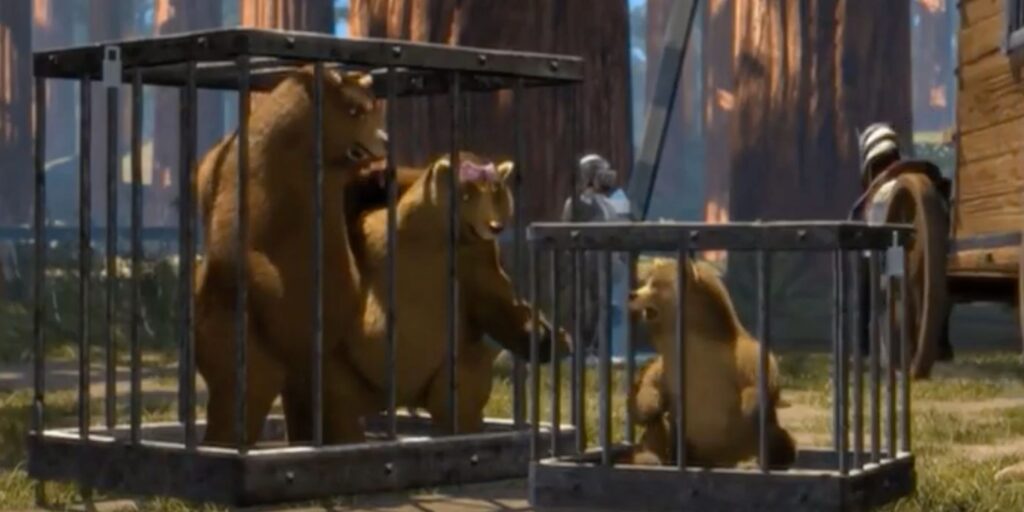
“You, there! Ogre!” the knights yell, already devaluing Shrek’s existence as an individual. “By the order of Lord Farquaad, I am authorized to place you both under arrest and transport you to a designated resettlement facility”. Wow, not even subtle that Lord Farquaad intends to colonize fairy tale land. Now, this is 2001. Plenty of horrific incidents of ethnic cleansing, eugenics, and colonization have happened throughout history at this point. There isn’t a specific historical the film is referring to, but what comes to mind most vividly while watching this movie is the genocide of indigenous people throughout the Americas, as well as the Holocaust. Again, this is a PG-rated film. Yet it has the power to allegorize horrific aspects of society. After all, fairy tales are, in essence, synonymous with allegory.
Our introduction to Farquaad continues after finding out that he has expelled all of the fairy tale creatures from their homes and dumped them onto Shrek’s property to start their lives anew. The pied piper is calling to mice, the old lady who lived in a shoe is hanging laundry to dry, and the Baby Bear from before is crying to Papa Bear. But wait, where is Mama Bear? Wasn’t she there before? Remember her absence because this will expose more of Farquaad’s evil later on.
When we finally meet Farquaad for the first time, he is waterboarding (or should I say milk-boarding?) the Gingerbread Man. “You and the rest of that fairy tale trash [are] poisoning my perfect world” he sneers, before torturing the Gingerbread Man further. This is where it is made clear that Farquaad genuinely believes that humans are superior to fairy tale creatures. In fact, he wants to round them all up to one spot for god-knows what. But believing the presence of a certain identity group is “poisoning” your world makes you a eugenicist.
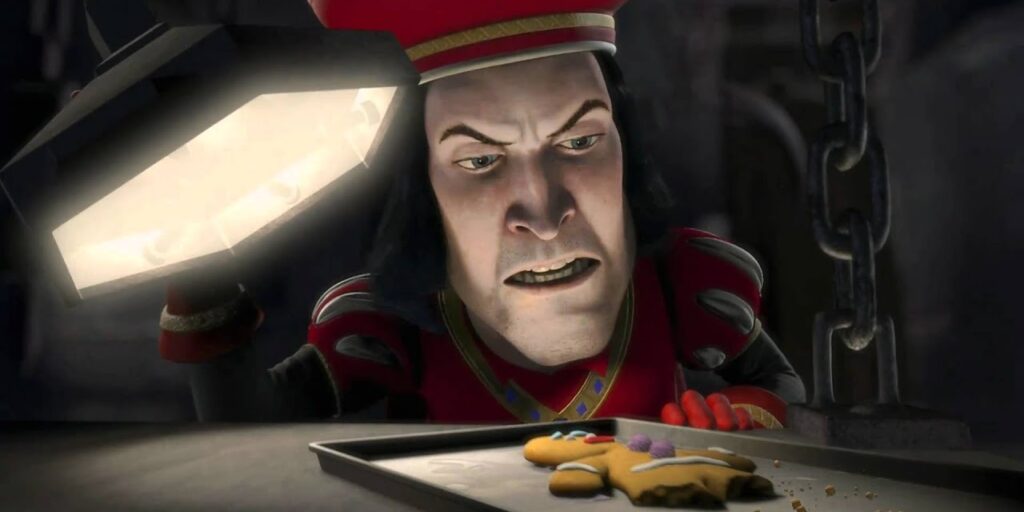
While the three bears, the Pied Piper, the Gingerbread Man, and all of the other fairy tale creatures never explicitly said “I deserve to be treated this way”, there is a vague form of consent given. By accepting Farquaad and acknowledging him as ruler, they provide him the power to continue his age of tyranny. As Janeway explained, power is derived from the relationship between the ruler and the governed. By them acknowledging he is the one in charge, they give him the power. But this is how systemic oppression works. People are broken down and threatened into submission. For their own safety, they must agree to this relationship of power, even though they know it is morally corrupt.
Shrek and Donkey arrive in Duloc. The place resembles Disney World with its mascots and memorabilia covering every inch of the land. They then approach the information booth. Doors open, and little robotic characters perform a song about Duloc being the perfect place. This is clearly a parody of It’s A Small World After All. However, this particular song is Farquaad-themed indoctrination. The second lyric is Don’t make waves, stay in line, and we’ll get along fine. A catchy song telling you how perfect your town is while also telling you to conform? Not only is that creepy as hell—that’s some authoritarian propaganda!
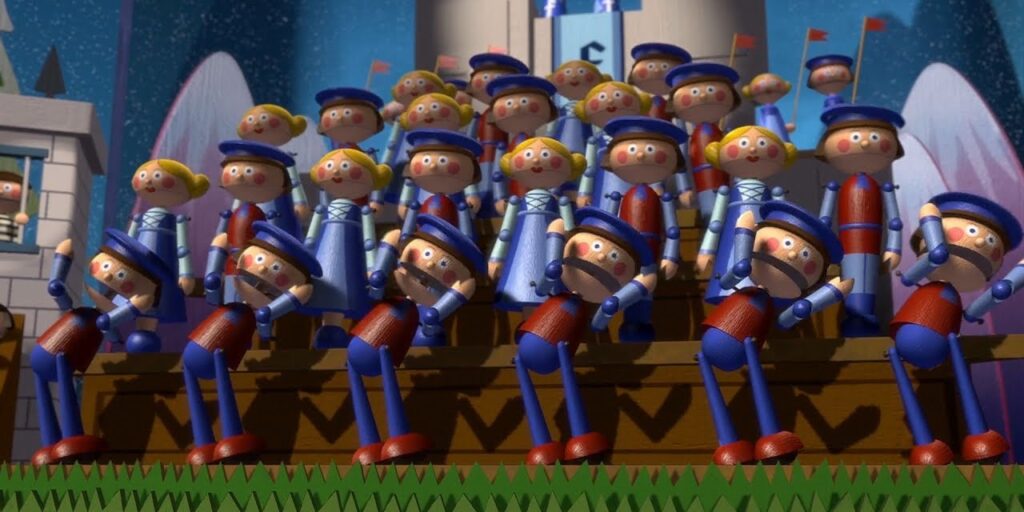
The constant association of Farquaad’s face with cheery, entertaining, and helpful elements of life is part of how he stifles his constituents into subordination. It’s Pavlovian. Even with all his tyranny, Farquaad’s face will make his constituents think of a fun mascot, or “The Happiest Place on Earth”. And they eat that up, further enforcing his place in power.
To determine who will rescue Princess Fiona, Lord Farquaad actually sets up a Battle Royale among the knights in his kingdom. “Some of you may die,” he informs the combatants. “But that is a sacrifice that I am willing to make.” The audience roars with glee in response to Lord Farquaad’s dedication. Who cheers at the potential death of their neighbors and community members for the sake of the ruling class? Those under authoritarian rule. Let’s also acknowledge that there are signs held up telling spectators to applaud or let out a sigh of fondness or whatever is applicable. Lord Farquaad treats his constituents like they are the audience at a live taping of Friends. That’s a creepy level of control for a ruler to have.
This scene is also the first meeting of Shrek and Lord Farquaad. Upon seeing Shrek, Lord Farquaad decides that whoever kills the ogre gets to save Princess Fiona. Shrek is opposed to this. He even jokingly says “Can’t we settle this over a pint?” showing that he would rather be diplomatic than violent. But, with all of the knights living in fear of both Shrek as a monster and Lord Farquaad as a dictator, they go in for an attack. Obviously, none of the knights can defeat Shrek.
What’s wonderful about this scene is it plays out over Joan Jett’s Bad Reputation. The lyrics I don’t give a damn about my bad reputation./You’re living in the past, it’s a new generation are echoed on screen by Shrek creatively kicking ass and butting heads. While this does reinforce society’s stereotype of ogres as violent and dangerous monsters, it is a way for Shrek to feel empowered. He is literally fighting for his right to live in the eyes of his oppressor. In fact, as the fight goes on, the spectators start to cheer for Shrek, with one elderly woman at one point yelling “GIVE HIM THE CHAIR!” to tell Shrek to go with a classic wrestling move. For the first time ever, humans are cheering for Shrek, and, in turn, Donkey. This is when Lord Farquaad decides that Shrek is the one to go save Princess Fiona. He makes him a deal—rescue Fiona, and he will return his swamp to how it initially was.
Immediately after this scene, we see Shrek and Donkey beginning their quest and walking through a field of sunflowers. Donkey acknowledges the hypocrisy of Shrek doing a favor for Farquaad in order for the dictator to revoke his wrongdoing. In a sense, Donkey is saying Shrek is upholding his part of the power relationship by agreeing to the legitimacy of the gentrification of his home. But Shrek just tells him to shut up.
Shrek and Donkey approach this newfound friendship of sorts very differently. Because Donkey feels safe with Shrek, he latches on to him. The idea of a bodyguard in the midst of what is implied to be a genocide of fairytale creatures is extremely comforting. Shrek is not accustomed to this acceptance though. Shrek is so used to people running and screaming at the sight of him that he actively pushes Donkey away. He cannot accept this affection because he has trained himself to reject it, for his own emotional wellbeing.
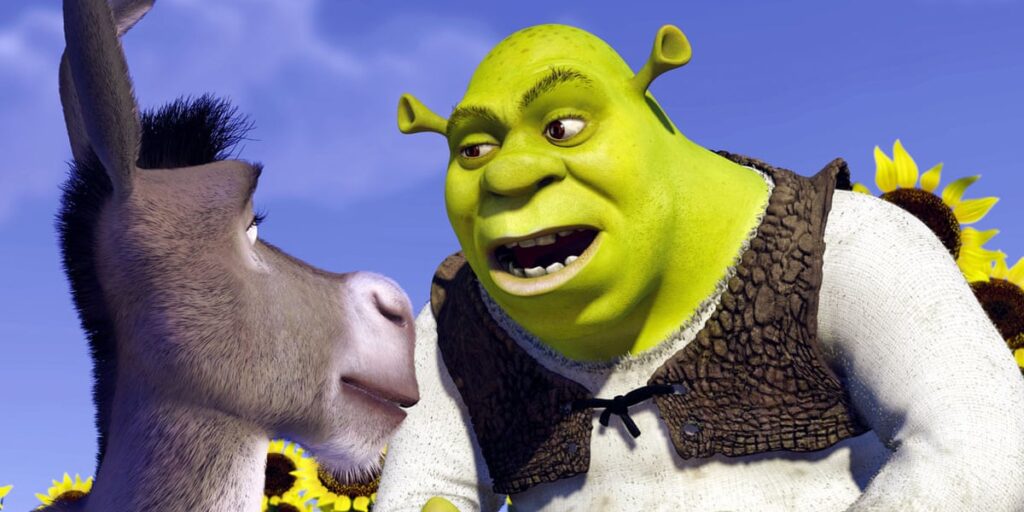
As explained in the iconic line “ogres are like onions; They have layers”, Shrek tries to show that he is not just some scary monster. Alas, these numerous layers are what prevent Shrek from ever getting close to another living creature. However, this is exactly how Farquaad upholds his position of power in relation to the fairy tale creatures. He stereotypes and shames them into isolation, making it less likely for them to collectively dissent and remove him from his throne. This is the same with Princess Fiona. Upon finding out Shrek is an ogre, she rejects him in part due to the systemically implemented prejudice against fairy tale creatures as well as the internalized prejudice she feels toward herself. The further the fairy tale creatures are kept from each other, the better.
Donkey finally starts to understand Shrek’s pain when we reach the halfway point of the film. As Princess Fiona sleeps, Donkey and Shrek look at the stars. Donkey talks about how he and Shrek will live together, but Shrek continues to push back. When Donkey finally calls him out on his callousness, Shrek starts peeling back the layers.
“I’m not the one with the problem. It’s the world that has a problem with me!… They judge me before they even know me. That’s why I’m better off alone”. Regardless of how much kindness and appreciation Donkey shows, Shrek’s isolation is self-imposed as a survival response to societal prejudice. And in order to protect himself, he has to see himself as a “big, stupid, ugly ogre”. However, Donkey makes it clear that he never feared Shrek. Fiona overhears this whole conversation. Even though we only see her eye watching them, it is implied by the gentle lute playing that she takes this conversation to heart. This scene further proves Janeway’s point that we implement the existence of power by falling into the stereotypical beliefs of the ruler.
Speaking of which, here comes the infamous scene of Lord Farquaad in his bedroom, looking at images of Fiona and becoming visually aroused. As the shot pans the room, look at the floor. Is that… no, it couldn’t be! MAMA BEAR IS THE RUG ON HIS FLOOR. However, no one ever really talks about this because this is the scene where it is implied that Farquaad has a boner. Because of that lewd joke, it’s easy to overlook the implication that Lord Farquaad had his knights separate the Three Bears and actually murder Mama Bear for decorative purposes. This is truly horrific. It reiterates his regard for fairy tale creatures as objects, not other living creatures who are just as much his constituents as humans. But why her? Was she punished for an isolated incident of dissent? Did she sacrifice herself for the sake of her young son, hoping he could see better days? We will sadly never know.
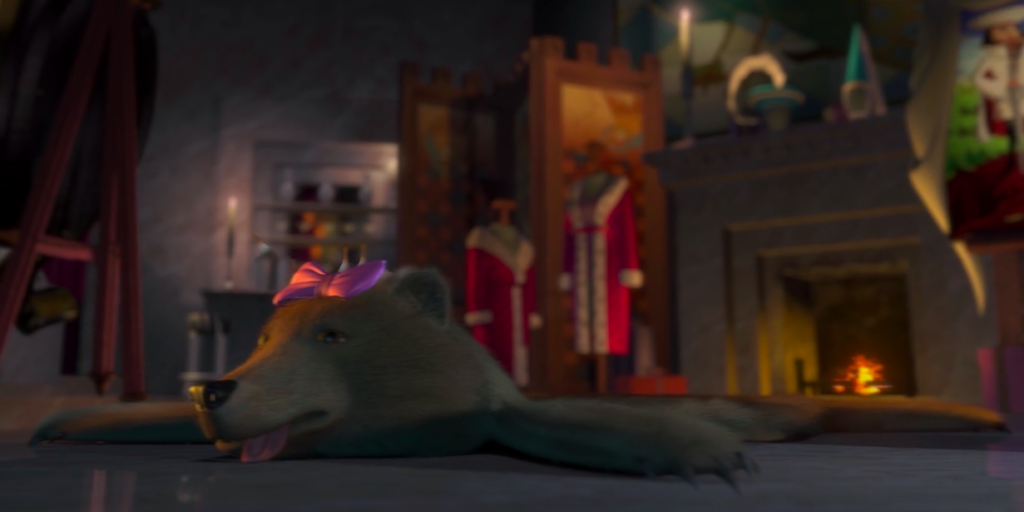
When Robin Hood and his Merry Men appear in the woods to “save” Fiona from Shrek, it is made clear how truly disgusted society is by the existence of ogres. Even when Fiona explains that there is no danger, the gang of Merry Men assume a threat. They attempt an attack on Shrek, but Fiona kicks all of their asses. On the surface, this scene is interpreted as a moment of building the character of Fiona beyond just a princess. But upon further examination, you realize that this is her first moment of standing up for her ogre identity. She knows these Merry Men are perceiving Shrek as a threat. If she was in ogre form, they would interpret her as a threat as well. She knows this is wrong. And this is her first stance against the societal prejudice of ogres.
What is interesting about this interaction is how Robin Hood, the fairy-tale/Disney character that symbolizes proletariat power, is limited by his own bigotry. The second verse to Robin Hood’s song are as follows:
I like an honest fight and a saucy little maid
What he’s basically saying is he likes to get… paid
So, when an ogre in the bush grabs a lady by the tush
That’s bad, that’s bad, that’s bad, that’s bad
When a beauty’s with a beast it makes me awfully mad
He’s mad, he’s really really mad
Now I’ll take my blade and ram it through your heart
Keep your eyes on me, boys, ‘Cause I’m about to staaaaart!
And then Fiona shuts the guy up by kicking him in the face with her Matrix moves. Robin Hood presents himself as a fighter of the oppressed by giving to those in need. Yet, in the second verse of the song, he admits that he becomes inherently angry at seeing a human and an ogre together. Now, is he truly a warrior for the oppressed if his prejudices match those of the ruling class? Nah. In reality, he has fallen victim to the Farquaadian propaganda used to pit the oppressed against each other.
After this, Shrek and Fiona start to see each other for who they really are, not just their socially imposed identities. The more time Fiona spends with Shrek, the more she realizes that her identity is not something to be ashamed of. She laughs as she and Shrek inflate animals like balloons. They enjoy eating some rotisserie style weed-rat. We see Fiona embracing the cultural traits of ogre identity. And it makes both her and Shrek truly happy.
Eventually, we get to the point of the movie where Fiona’s big secret is revealed: a witch cast a spell on her as a baby that makes her turn into an ogre when the sun is down. This is plot point is reminiscent of Beauty and the Beast when the Beast reveals he desires nothing but to be human again. But the two films differ once Donkey suggests that Fiona doesn’t have to follow society’s expectations of beauty or marriage. But she still believes in the societal expectations that oppress her true identity. She still feels she must marry Lord Farquaad in order to become truly normal, which, in this situation, equates with being a human. One question I wonder is how much of her desire to marry him is based in societal expectations and how much is a survival tactic under Farquaad’s iron fist.
Fast forward to Fiona and Farquaad’s wedding. We see the return of audience cues. As the wedding guests awe, we see a sign held up that says “reverence”. It is then changed to “revered silence”. There are (tall) statues of Lord Farquaad throughout the chapel. The control this man feels the need to have is sickening.
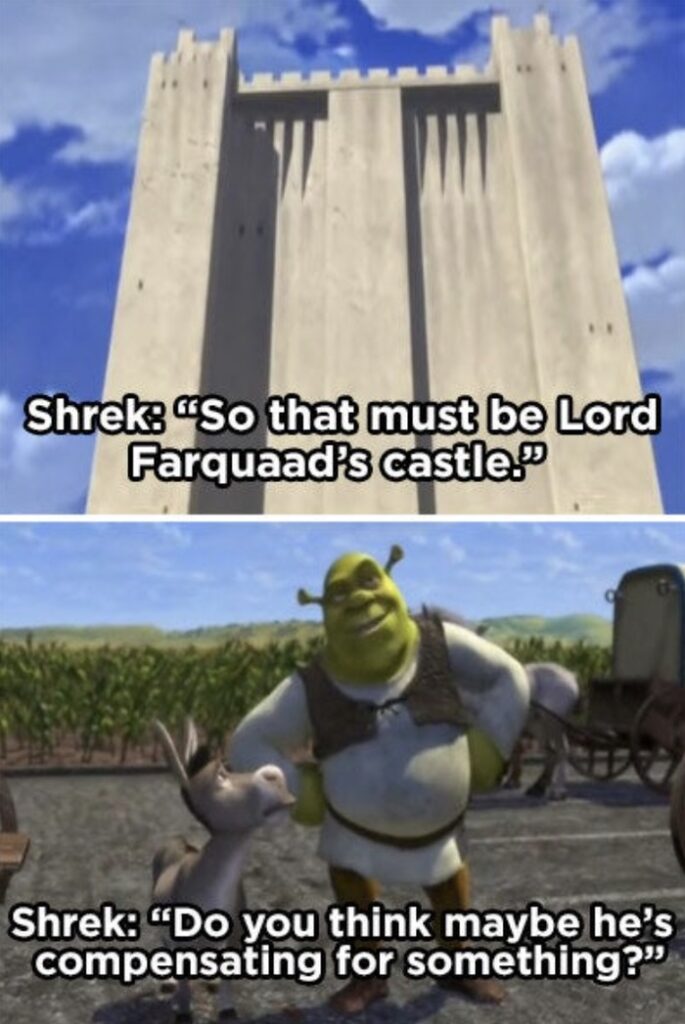
Shrek bursts into the wedding, yelling his objection. Farquaad rolls his eyes and says, “It’s already rude enough to be alive when no one wants you to be, but showing up to a wedding uninvited?” Right off the bat, this authoritarian asshat feels the need to demean those different from him. This line delivery occurring in front of all the tall statues of Farquaad really cements the idea that his immense level of bigotry is likely rooted in deep levels of self-hatred. When Shrek starts to get bashful while confessing his love to Fiona, Farquaad laughs. The audience cues then tell the wedding guests to laugh. They join him. This furthers the confirmation that Lord Farquaad promotes not only institutional oppression, but the creation of fairy tale creatures as social pariahs as well. By making a mockery of others, he empowers himself.
Farquaad hates Fiona immediately after she transforms into an ogre, even though marrying her still makes him a king. He then starts to refer to her as “it” like he does with Shrek. He puts on the crown and yells for order and perfection, claiming he is king. Shrek whistles, and Dragon appears, swallowing Farquaad whole. Everyone immediately stops. The knights stop trying to harm Fiona and Shrek. Then everyone claps. This man was genuinely hated by everyone in Duloc, but they obeyed his authoritarian regime. It is a shortcoming of the film that they never even allude to why humans followed him. Was it out of fear of reprisal from the dictator? Was it a sacrifice they made in their values for the sake of living comfortably in Duloc? Were they just attracted to whoever in the room was the most powerful? I am drawn to believe the third, considering how spectators thrived off of Shrek’s performance at the Battle Royale earlier.
Upon Shrek and Fiona’s kiss, Fiona begins to transform into “true love’s form”. This transformation is filled with glitter, light, and angelic music. The power of this transformation blows out the chapel windows. The stain glass on the chapel windows were images of—you guessed it—Lord Farquaad, but tall. This is symbolic in how loving yourself is a revolutionary act in the face of systemic oppression. Something marginalized groups are so often taught is that they must make themselves as small as possible, take up as little room as possible, in order to avoid conflict. Janeway believes this is an assertion planted by the powers that be in order to further prevent the governed from overcoming oppressive systems. And the visual of Fiona’s transformation blowing out the images of Farquaad is a great example of her overcoming oppression.

Shrek and Fiona’s wedding is another great example of communal connection that takes away power from the oppressors. At the wedding, humans and fairy tale creatures are not only intermingled, but they are fraternizing. The Gingerbread Man is beating a tiny statue of Farquaad, Papa Bear and Baby Bear are actually dancing! I can only imagine Farquaad is rolling over in Dragon’s stomach in anger.
The fairy tale creatures, and humans, who lived under the oppression of Lord Farquaad are free. They have collectively revoked their consent to the power relationship they have been tortured under for so long. This may be a wedding, but they are celebrating so much more! “I believe” is repeated until the movie fades out. At the end of this movie, not only does everyone believe in love. They believe in a life after authoritarian rule. They believe in both personal and communal power. And they deserve to love themselves without fear of repercussion. Because self-love may be the greatest form of any power out there.
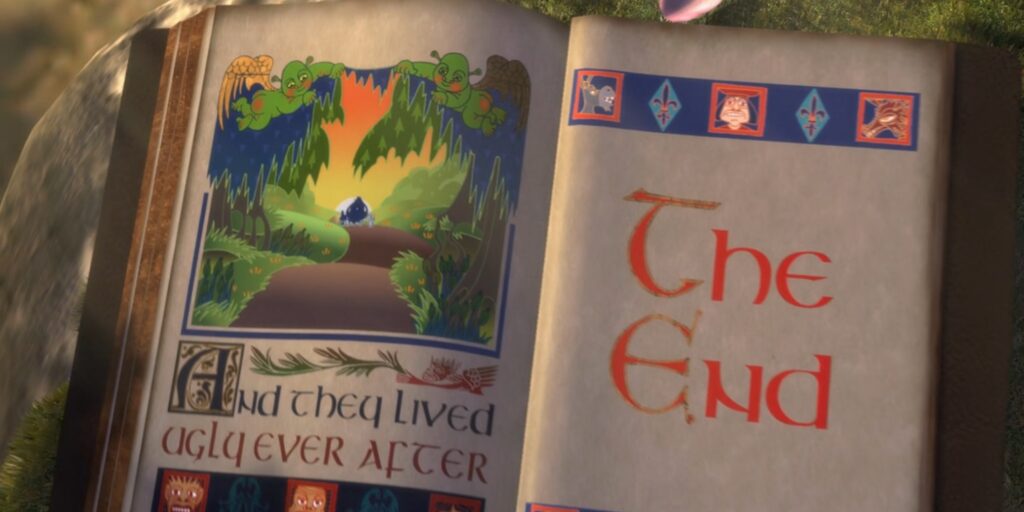
References
Powers of the Weak by Elizabeth Janeway
About the Author

Molly is a Disability Justice Advocate with a background in Social Science. They spend most of their time over-analyzing TV shows and yelling about local politics. They live in Minneapolis with their partner and two cats. You can follow them on Twitter at @dunktankdoug
